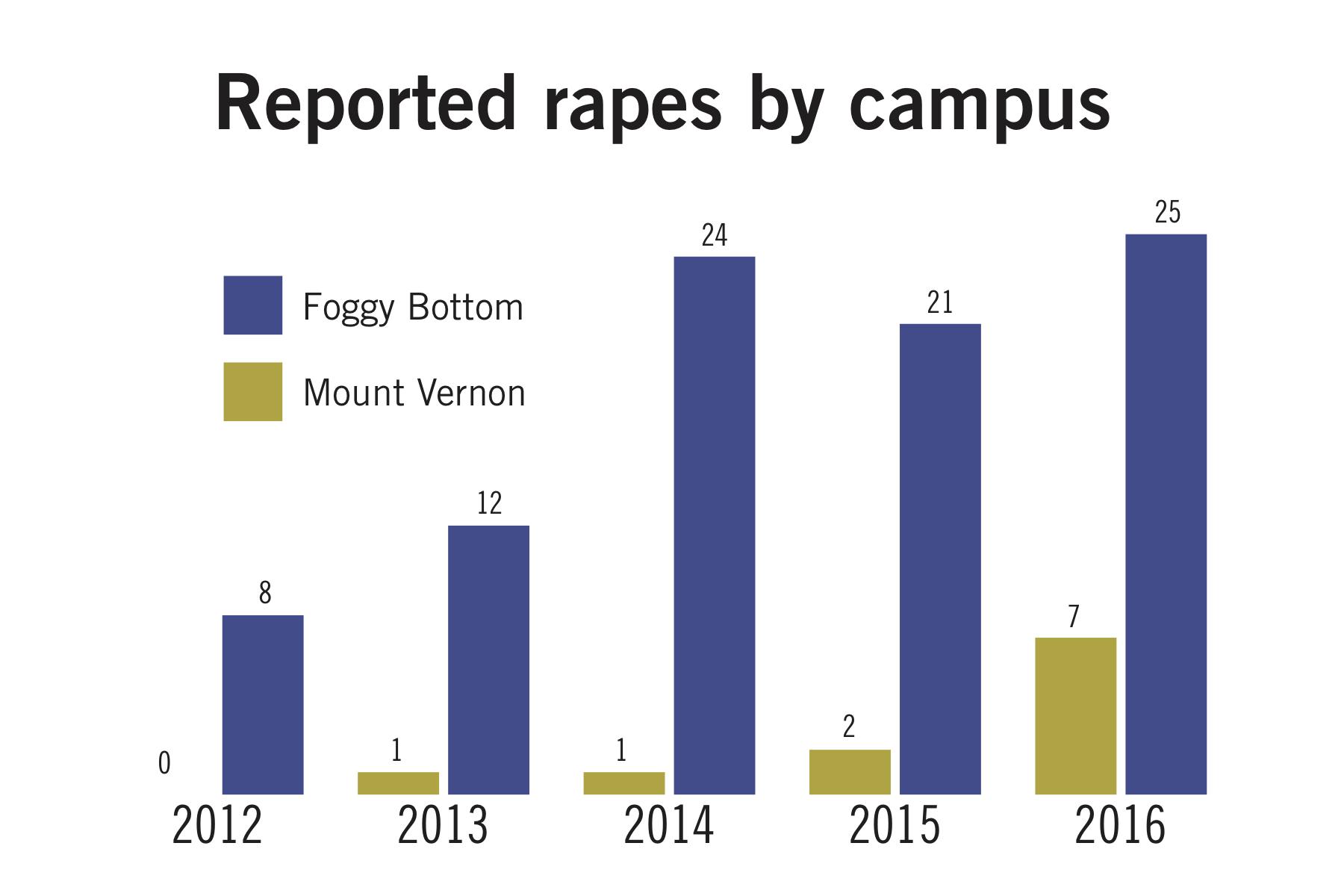
Yonah Bromberg Gaber | Graphics Eidtor
Annual Security Report
Updated: Oct. 20, 2017 at 11:15 a.m.
Rape cases on the Mount Vernon Campus rose last year to the highest point in at least five years – even as cases have remained relatively stable on the Foggy Bottom Campus.
Between 2012 and 2015, the number of rapes recorded on the Vern never exceeded two, but seven rapes were documented on the campus last year, according to the annual security report. Experts said it was difficult to say why cases increased last year, but it could be the result of more mental health resources available on the Vern.
Darrell Darnell, the senior associate vice president for safety and security, said he was concerned about the increase in rapes, but credited programs like the mandatory freshman sexual assault prevention training for making students more aware of Title IX policies and ways to report incidents.
Darnell said he didn’t think a change in the culture or environment at the Mount Vernon Campus would have caused the increase in incidents. He said buildings and access controls have not changed, but instead security officials monitor where students are gathering.
“The physical aspect of the building is not going to change,” he said in an interview last month. “It’s the behavior that’s going to change, and that’s what we try to keep track of.”
From 2012 to 2015, the reported number of rapes on the Mount Vernon Campus had been relatively minimal, ranging from zero in 2012 to two in 2015 before last year’s rise, according to the report.
After surging from five to 24 incidents between 2012 and 2014, the number of rape cases on the Foggy Bottom Campus has hovered between 21 and 25 from 2014 to 2016, according to annual security reports.
Experts said the more resources available for students on any campus, the more likely students are to report incidents.
In recent years, the Mount Vernon Campus has focused more on mental health services after three students living on the Vern died by suicide on the campus in the spring of 2014. The string of deaths sparked the University to move a counseling services location to the campus in the fall of 2014.
Josh Bronson, the director of training at the International Association of Campus Law Enforcement Administrators, said adding a new counseling center to campus could give students another outlet to receive information about where to report.
“If there is an increased presence on the campus and people are given resources and told ‘you can go here, here and here,’ then more people generally come forward and tell someone about it,” he said.
Bronson said the amount of police presence on a campus will affect how many students report to officers because if they are visible, students have better experiences and are often more open with them.
“Generally speaking it doesn’t matter what the size of the campus is,” he said. “It matters what they are doing on the campus to promote the fact that they have these different programs.”
The University launched an anonymous, student-run peer hotline in January, giving students the chance to seek help about any issue. GW also created a website that puts all of its Title IX resources in one place, making it easier for students to respond to sexual abuses and assaults.
Six of the rapes documented on the Mount Vernon Campus were reported to campus security authorities, faculty or staff who have a role in campus security or overseeing campus activities and are required to report incidents they learn about. Another case was reported to the Metropolitan Police Department.
On the Foggy Bottom Campus, 22 were reported to CSAs, while two were reported to the University Police Department and one was handled by MPD, according to the report.
Eric Coleman, a University lecturer in criminal justice at the University of North Texas, said officials would need to find out if the seven incidents were related and monitor whether this increase persists in the coming years to determine if this year’s increase is cause for concern.
“I would say you would have a problem if that continues over two to three year period where you see that sort of uptick, but it could just be an anomaly,” he said.
This post was updated to reflect the following correction:
The Hatchet incorrectly reported Josh Bronson’s first name. It is now correct. We regret this error.




